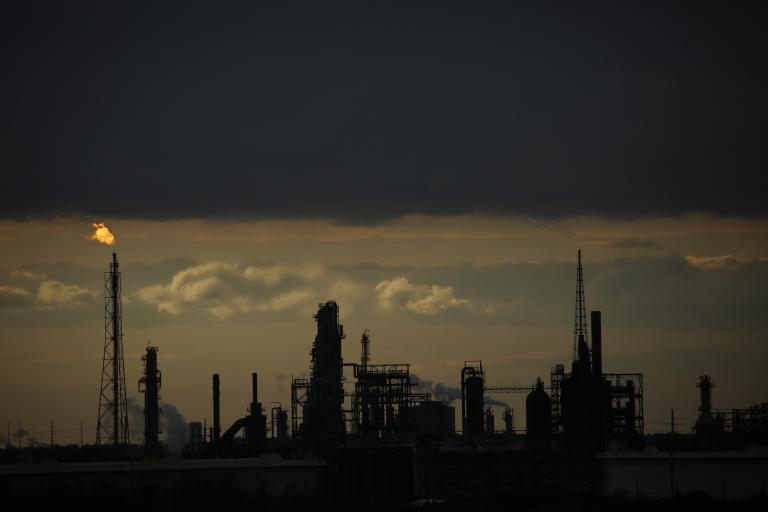This story was supported by the Pulitzer Center. It is being co-published with Public Health Watch and the Investigative Reporting Workshop.
Hannah Molina was buckling her toddlers into their car seats for Wednesday night church when she noticed the faint chemical odor.
She felt a little lightheaded, but she didn’t think much about it.
The air is often stinky in Jacinto City, Texas, a small town 15 minutes east of downtown Houston that’s surrounded by oil refineries and petrochemical plants. Usually, the odors are fleeting. Enough to make Molina’s nose wrinkle, but not enough to trigger her asthma or keep the girls from playing outside.
That night — July 14, 2021 — turned out to be different.
By the time Molina got home at 9 p.m., a nauseating, garlic-like stench had settled over her neighborhood. When she opened her car door, she felt dizzy. She swallowed hard to avoid gagging.
Molina got the girls out of the car, grabbed the groceries she’d picked up at Walmart and stumbled into the little house she and her husband rent. She drew a deep breath, desperate for clean air. But the odor was inside, too.
The noxious fumes felt like a straightjacket around her chest. Her lungs tightened, a signal that her asthma was flaring up. Her eyes burned and her throat stung as if she’d suddenly developed strep throat.
She managed to put 1-year-old Sophia into bed, then collapsed onto her couch, the grocery bags strewn next to her.
“Mama, my stomach hurts,” 2-year-old Maribel said.
Then Maribel vomited.
Molina pushed herself off the couch. It took everything she had just to stand.
“I just went into straight-up mom mode,” she said. “I had to keep my girls safe.”
Two miles away, in the town of Galena Park, Juan Flores was coughing and gagging, too. For hours, his phone had been ringing with calls, texts, and Facebook messages about the smell. Now he was driving through the neighborhood where he’d spent his whole life, trying to figure out where the odor was coming from.
Galena Park, Jacinto City, and other low-income communities are clustered on the east side of Harris County, the third most-populous county in the United States and the epicenter of North America’s petrochemical industry. Ten oil refineries process 2.6 million barrels of crude oil a day. Thousands more facilities store or manufacture the chemicals the industry uses and produces. Trucks and rail cars carrying industrial equipment and synthetics rumble through neighborhoods.
Southeastern Texas — especially the Houston area — is known for its lax zoning laws, so petrochemical plants loom over houses and playgrounds where children gather every day. Forty percent of Galena Park’s 11,000 residents, including Flores, live within a mile of an industrial facility. A terminal that can hold more than 10 million barrels of chemicals lies seven blocks from the middle school. Two metal fabrication companies sit directly across the street from city hall.
Flores works for Air Alliance Houston, a nonprofit that combats pollution in heavily industrialized neighborhoods. He installs inexpensive air monitors outside homes so residents can get some basic information about the dangers they are living with. The Texas Commission on Environmental Quality, or TCEQ, is charged with protecting the public’s health. But Flores doesn’t trust the TCEQ. When he calls to complain about foul odors, the state agency frequently waits hours — sometimes even days — to respond. The odor is often gone long before an inspector shows up.
Instead, Flores relies on his community network and, increasingly, Harris County Pollution Control Services, which has been beefed up in recent years by county politicians determined to rein in polluters when the state won’t act. Pollution Control’s authority is much weaker than the TCEQ’s, but at least the people there take his calls.
Flores knows, firsthand, the dangers petrochemical facilities pose to low-income communities like his.
In 1989, 23 workers died and 314 were injured when explosions broke out at a Phillips Petroleum plant three miles from Galena Park. Flores was a sixth-grader back then. The blast was so powerful that it shattered windows at his school and shook the portable classroom where he was studying.
In 2017, floodwaters from Hurricane Harvey struck two tanks at the Magellan Midstream Partners facility, about half a mile outside Galena Park. More than 460,000 gallons of gasoline poured out, the largest petrochemical spill ever caused by a natural disaster in Texas. Flores smelled the fumes back then as he walked through the town, documenting storm damage. He still doesn’t know exactly what was in the air, because the TCEQ had shut down its air monitors to protect them from Harvey’s driving rains.
In 2019, a gasoline-fueled inferno roared through an Intercontinental Terminals Company facility 20 miles east of downtown Houston. Flames from the facility — which can hold more than 13 million barrels of petrochemicals — shot more than 100 feet into the air. Billows of thick, black smoke darkened the sky above Flores’ home. The fire lasted three days and released so much benzene, a carcinogen that can cause leukemia, that Galena Park residents were advised to shelter in place. Flores’ wife and 14-year-old son were so sick that a doctor prescribed steroids to ease their labored breathing.
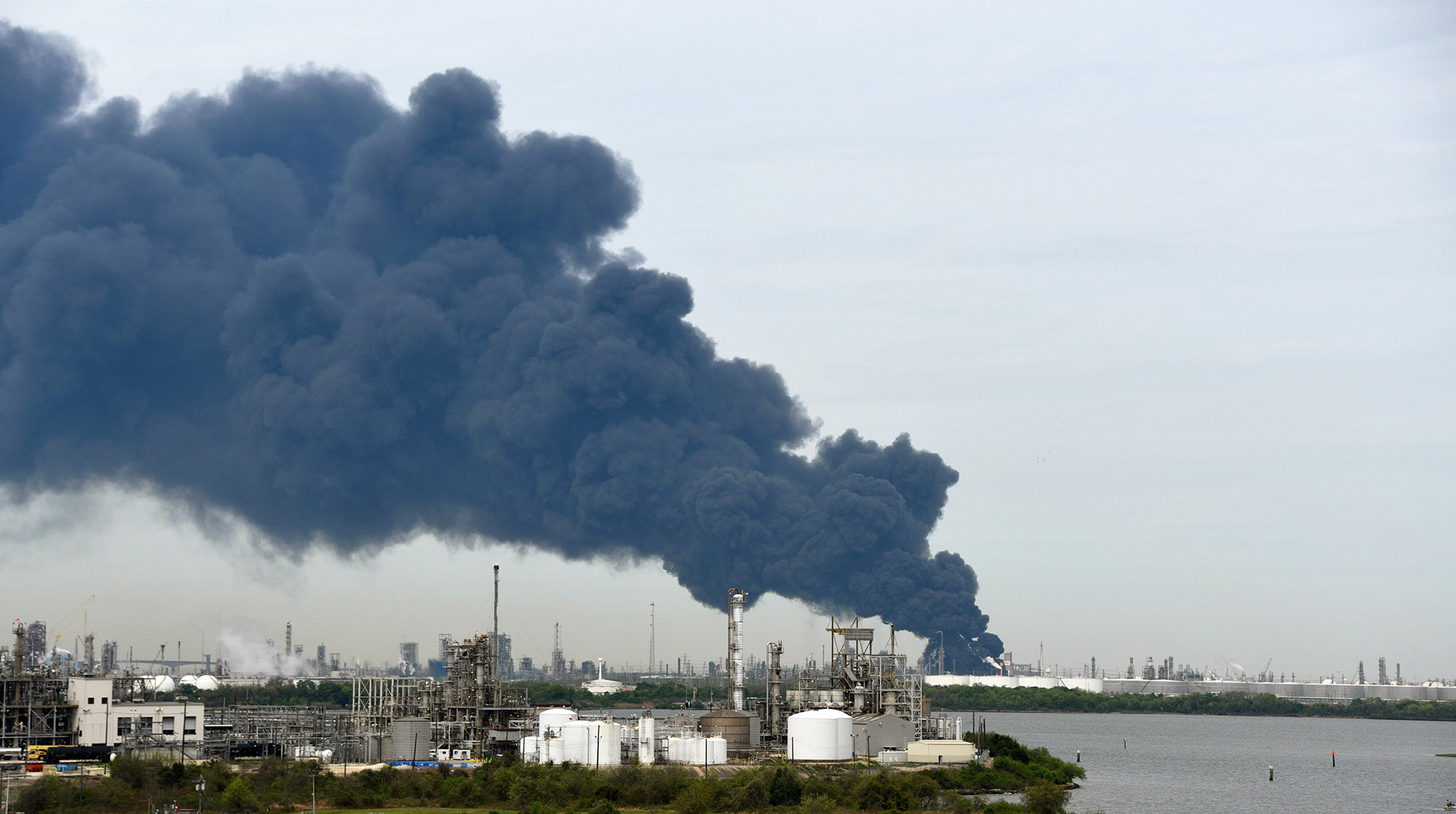
Fear of another terrifying accident isn’t what keeps Flores up at night, though.
What worries him far more are the routine chemical releases like the one he encountered as he drove through Galena Park on July 14, 2021. The quiet events. No fire. No explosion. No warning. No immediate deaths. Just silent streams of toxic fumes that many residents accept as a fact of life.
There have been 472 illegal releases — about 16 every month — in Harris County since 2020, according to an examination of TCEQ records by Public Health Watch and the Investigative Reporting Workshop. But watchdog groups think the state’s count is a conservative one. The Environment Texas Research and Policy Center found that the Houston area had an illegal industrial pollution event almost every day in 2019 alone.
To Flores, the noxious odors aren’t “the smell of money” that Texas politicians talk about when they boast of the economic benefits and well-paying jobs the oil, gas and chemical industries bring to their state. They’re the smell of illness and sometimes death — a smell that affects some Harris County communities far more than others.
Affluent, predominantly white residents live on the county’s suburban west side, far from the petrochemical industry’s gritty core. A 2019 analysis by the Episcopal Health Foundation found a 21-year-gap in life expectancy between west side neighborhoods like River Oaks, where the median home price is $2 million, and low-income east side communities like Galena Park, where the median home price is $170,000.
People there are exposed to pollutants nearly twice as often as white residents, according to a study by the Natural Resources Defense Council and Texas Environmental Justice Advocacy Services. That includes volatile organic compounds like 1,3-butadiene — a carcinogen used to make plastic and rubber products — and fine particulate matter released by power plants, refineries and batch concrete facilities. Fine particles are too small for the eye to see and can settle deep into lungs and seep into bloodstreams. In 2015 alone, 5,213 Harris County residents died prematurely due to fine-particle exposure, according to scientists at Harvard University and the Environmental Defense Fund.
Flores sees these statistics playing out in Galena Park, where four out of five residents are Latino and nearly 30 percent live below the poverty line. His 6-year-old daughter, Dominique, was born with a malignant tumor in her stomach that required chemotherapy and multiple surgeries before her first birthday. His father died of a heart attack on the job at age 51 after working more than two decades in refineries. He has seen generations of neighboring families ravaged by cancer.
“Everyone knows someone who’s died of cancer,” said Flores, who turns 45 in October. “That’s just how it goes around here.”
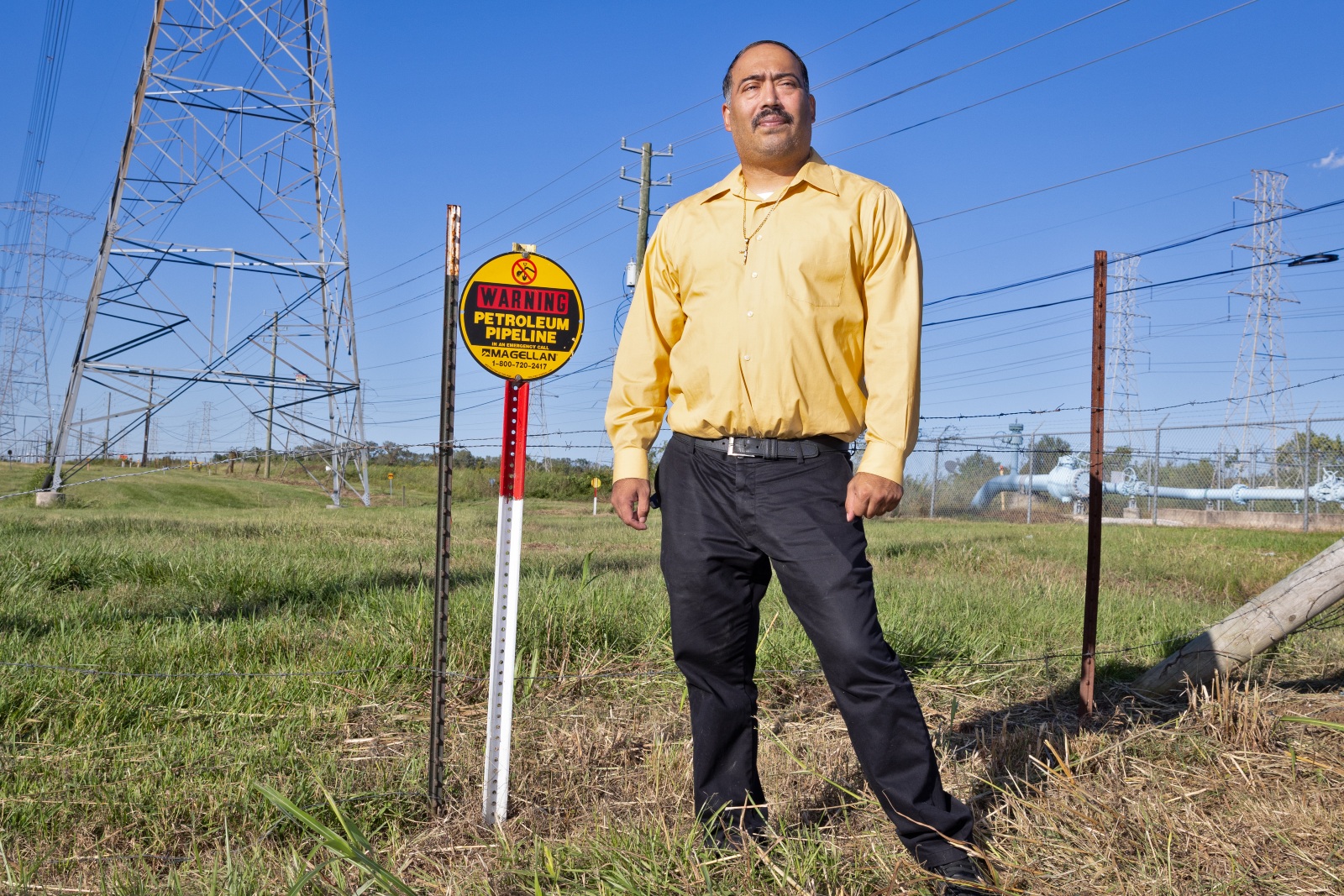
On July 14, 2021, Flores wasn’t thinking about his town’s past struggles. He was worried about the garlic-like odor that was making him dizzy right now. By 11 p.m. the stench was bad — the worst he’d smelled in years.
He drove up and down Galena Park’s streets, still wheezing. It was quiet, save for some teenagers playing pickup basketball, seemingly oblivious to the stink that hung in the dense summer air.
He stopped by the house where he’d grown up to check on his mother. The odor was bad there, too, but she was safe inside. He kept driving.
He turned onto Clinton Drive, the thoroughfare that separates the city’s southern edge from the Houston Ship Channel. More than 400 petrochemical plants line that murky waterway, which runs north from Galveston Bay and then turns west and carries ships to within four miles of downtown Houston.
The odor got stronger as Flores drove east along the channel. In the distance, he saw a flame flickering above Houston Refining, one of the largest refineries in the United States. It was a sign that the facility was flaring, a common method of burning off the excess natural gas and chemicals produced during refining and petrochemical manufacturing.
He started gagging again. His throat burned. He could barely speak.
When flares are operated correctly, they can efficiently burn pollutants and limit emissions. But a poorly executed flare can release contaminants like black carbon and benzene, and Texas environmental organizations are suing the U.S. Environmental Protection Agency, or EPA, for failing to curb the practice. Flaring occurs up to 20 times more often in Texas than in other states, according to a 2017 report from the U.S. Department of Energy.
A hazy yellow plume swirled above the street 50 feet ahead of Flores’ headlights. The odor was the strongest it had been all night. He coughed so hard that the gold cross he wears around his neck bounced against his chest.
“Oh, God,” he groaned, slowing his car to a crawl. “That’s got to be it.”
Through the haze, Flores spotted the flashing lights of an emergency vehicle from Harris County Pollution Control.
Pollution Control had been searching for the odor since earlier that evening, when it began getting calls from worried residents.
Latrice Babin, the department’s director, could smell it from her office in Pasadena, a notoriously contaminated town directly across the Ship Channel from Galena Park. The odor was faint at first — just the familiar aroma of the industry that had surrounded Babin since she was a child. But it quickly grew stronger, and she knew something was seriously wrong.
Babin was born and raised in Crosby, a small industrial town in northeastern Harris County. She swam and crabbed in the San Jacinto River, which always had a particular stink to it. Her dad worked in a petrochemical plant, and the scent of the synthetics clung to his work clothes when he got home at night.
“My father used to literally dip his shirt in chemical solvents to cool his body off,” she said. “We just didn’t know any better.”
Babin’s dad died of cancer at the age of 63. The segment of the San Jacinto River where she once swam is now a federal Superfund clean-up site, polluted by cancer-causing dioxin released from the nearby International Paper plant.
Babin has dedicated her life to giving future Harris County residents something she and her family never had: a sense of agency.
In 1992, she got a degree in biology from Texas Southern University, a historically Black college in Houston where she met Robert Bullard, a professor known as the father of the environmental justice movement. In 1996, Pollution Control hired her as an environmental investigator. She got a Ph.D. in environmental toxicology from Texas Southern and began moving up the ranks.
Pollution Control was so underfunded in those days that some of the equipment she used hadn’t been updated since the 1970s. The county mostly relied on the TCEQ to gather information about pollutants and police the responsible parties.
But the TCEQ was cash-strapped, too, thanks to then-Gov. George W. Bush’s lenient stance on environmental regulation. The former West Texas oilman championed a 1995 law that prioritized voluntary, industry-led solutions over government mandates — an approach one of his opponents described as “a lot of sweet talk with no teeth in it.”
In 2004, Houston, the largest city in Harris County, tried to force the state to take action against big polluters.
“The public owns the air… and nobody has the right to alter it chemically,” then-Mayor Bill White declared in his inaugural speech.
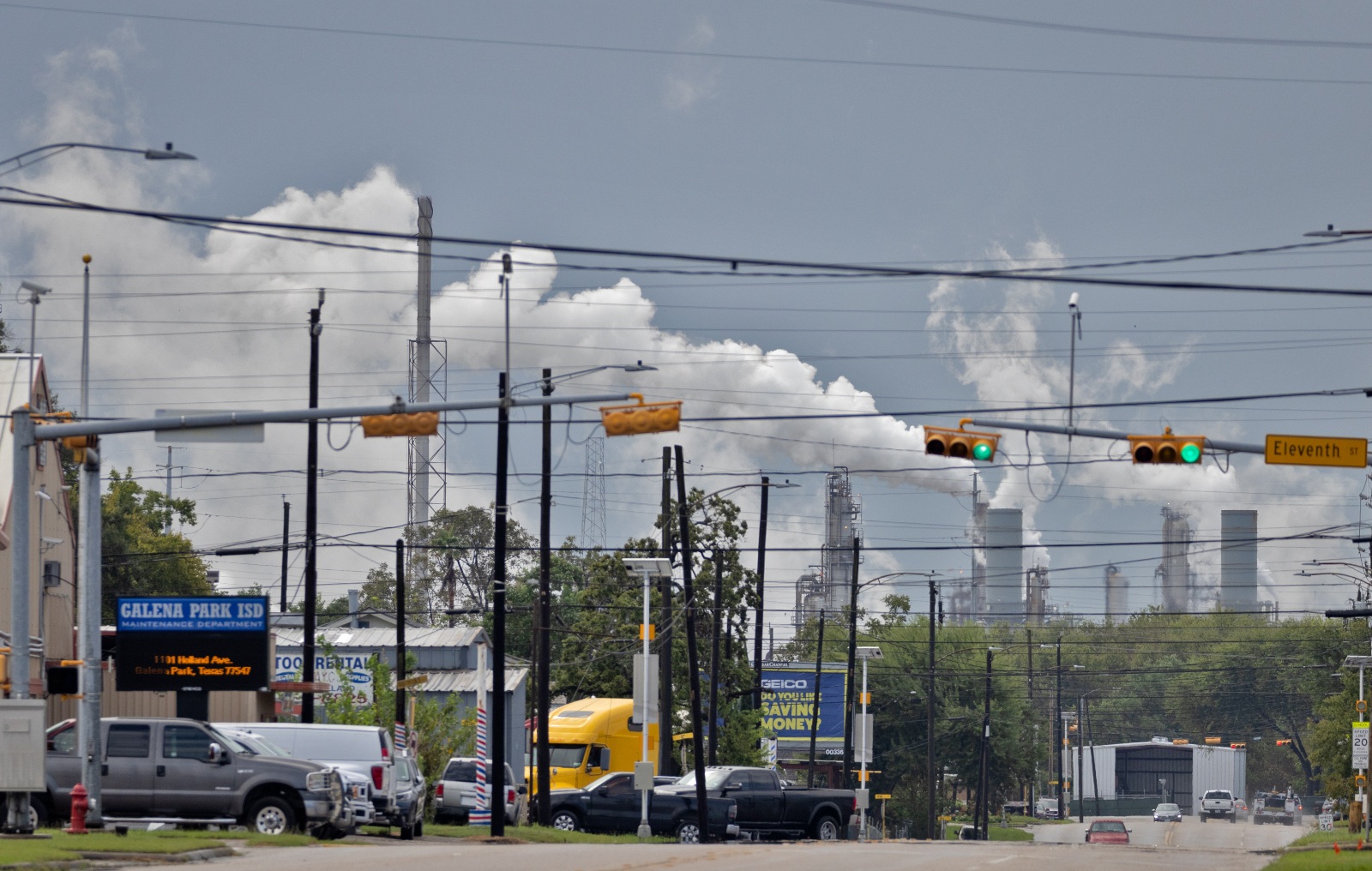
White, a Democrat who had served as deputy secretary of energy in the Clinton administration, championed two ordinances that gave the city authority to monitor and punish serial polluters. The ordinances didn’t impose any new regulations. They simply allowed the city to enforce existing rules the TCEQ tended to ignore.
But Houston’s ordinances were quickly challenged.
A coalition of petrochemical giants that included Dow Chemical and Exxon Mobil filed a series of lawsuits that dragged on for nearly a decade. Greg Abbott, who was elected governor in 2014, filed a legal brief supporting their cause.
“The Texas Constitution and Texas statutes prohibit city officials from interfering with the State’s enforcement of environmental regulations,” Abbott said in a statement his office released about the 2015 filing. “I am committed to promoting economic development and job growth in the state of Texas by reducing the regulatory burden that drives up the cost of doing business.”
That same year Abbott signed a law that made it even tougher for local governments to sue serial polluters.
House Bill 1794 set a $2.15 million limit on the amount of money a county could receive from pollution lawsuits — a sum so small that it barely covered the cost of a legal battle that would almost certainly last for years.
In 2016, the Texas Supreme Court killed Houston’s air-quality ordinances once and for all. The nine judges, all Republicans, ruled 8-1 that the city had overstepped its authority. Only the TCEQ — and, by proxy, the industry-friendly Texas Legislature — had the power to police polluters, the court held.
In 2018, another uprising began in the Houston area, this one led by county officials.
Lina Hidalgo, then 27, was elected county judge that year, the most powerful office in the state’s largest county. Her longshot victory over a Republican incumbent made her the first woman and first Latina to hold the office. It also made her the presiding officer over the Harris County Commissioners Court, which controls a multibillion-dollar budget and sets policies for everything from public health to law enforcement.
Hidalgo was born in Colombia, but moved to middle-class, suburban Houston at the age of 14. She earned a bachelor’s degree in political science from Stanford University, and a joint degree in public policy and law from Harvard and New York University.
One of Hidalgo’s goals was to shore up the county’s Pollution Control department, so it could at least try to step in when the TCEQ failed to act.
“These bad actors shouldn’t have free rein to lead to severely worse health outcomes for my family or pollute with impunity,” she told Public Health Watch. “Laws do exist. The problem is they’re not really enforced.”
When Hidalgo took office, there were two Republicans and two Democrats on the four-member commissioners court. Hidalgo had the swing vote, giving Democrats control for the first time in 30 years.
She didn’t hesitate to use that power.
In 2019, Hidalgo pushed the court to ramp up environmental protections. It set aside $850,000 to hire four assistant district attorneys to prosecute environmental crimes. It gave Pollution Control $5.9 million to hire 29 employees and buy air monitors and a mobile lab. It directed $4.6 million to the Fire Marshal’s Office, the lead responder in petrochemical accidents, so it could double the size of its hazardous materials, or HazMat, team.
In 2020, the first year of the COVID-19 pandemic, Hidalgo cast the deciding vote on a 3-2 decision that created the most expansive voting system in Texas history — a system that made voting easier for low-income communities of color like Galena Park. It expanded drive-through and mail-in ballot options. It also added more than 100 polling places, including some that stayed open 24 hours, and dramatically increased the number of election workers.
More than 1.6 million people cast ballots that November, the biggest turnout in Harris County history. One of those swept into office was 32-year-old Christian Menefee, the first Black man elected county attorney. As the region’s chief civil lawyer, he had the power to file lawsuits against polluters if the state refused to take action.

Menefee’s victory gave Hidalgo a key ally. He knew what it was like to feel powerless in the face of industry giants.
Menefee’s father and grandparents grew up in Houston’s Fifth Ward, just east of downtown. The historically Black community, once a safe haven for people freed from slavery, had been ignored by city leaders for more than a century. By the time Menefee walked its streets as a child, it was economically depressed, haphazardly industrialized, and riddled with public health hazards.
In 2021, the Texas Department of State Health Services reported that the rate of childhood leukemia in the Fifth Ward was nearly five times higher than expected based on statewide cancer rates. The health department also found a cancer cluster in homes near the Union Pacific rail yard, where a decades-long drip of creosote — an oily substance used to treat telephone poles and railroad ties — had been discovered.
Menefee, whose older brother battled childhood leukemia, knew what it was like to watch a loved one languish in the hospital. He wanted better for the Fifth Ward and other East Harris County communities like it.
Environmental justice leaders were encouraged by the elections of Hidalgo and Menefee. Denae King, associate director of Texas Southern’s Bullard Center for Environmental and Climate Justice, grew up in Kashmere Gardens, on Houston’s east side. The sound of scraping metal from a car-crushing business filled her childhood home, and fumes from a garbage facility seeped into her elementary school classrooms.
King had watched aunts and uncles die of cancer. And she’d watched too many elected officials ignore her community’s plight — just as they had overlooked the work of her mentor, Robert Bullard, for decades.
King had learned long ago not to pin her hopes on the promises of politicians. But Hidalgo and Menefee’s arrival felt different. If the TCEQ and state leaders wouldn’t clean up Harris County, maybe these young politicians would hang onto their offices long enough to do it themselves.

As the garlic-like odor settled over Galena Park and Jacinto City on the night of July 14, 2021, the county’s upgraded Pollution Control department took action. Its investigators visited nearly a dozen petrochemical plants, asking if they’d had any accidental releases. Lab experts combed through the EPA’s Toxics Release Inventory, a national database that contains the publicly listed chemicals used or stored at each facility.
Pollution Control investigators also checked the new state-of-the art air monitors they had installed to document the flow of toxins into various neighborhoods. The monitors weren’t set up to keep tabs on individual plants, but sometimes they scooped up enough distinctive particles to pinpoint an offender.
By midnight, however, nothing significant had shown up. No company had owned up to an accident. And the odor still hadn’t gone away.
Public Health Watch pieced together what happened next from interviews, Pollution Control investigation reports and TCEQ documents.
On the morning of July 15, Latrice Babin’s investigators returned to Clinton Drive, where Juan Flores had seen one of their SUVs parked the night before. They spent the next several hours retracing wind patterns and driving around the Ship Channel, hoping their noses would lead them to the odor’s source.
A TCEQ investigator arrived in Galena Park that afternoon, 21 hours after the agency received its first complaints about the garlic-like smell. Asked why the agency waited so long to respond, a spokesperson said “the TCEQ prioritizes complaints for investigation based on the allegations. This complaint was prioritized for investigation within 24 hours.”
The TCEQ investigator checked the readings at an air monitoring station, took additional readings with a handheld monitor and visited some facilities. The TCEQ then referred the complaints to Pollution Control and took no further action that day.
It wasn’t until about 5:30 p.m. — a full day after Galena Park residents started coughing and gagging — that investigators got their first big break. Houston Refining, the plant whose flare Flores had spotted the night before, had notified the TCEQ of a chemical leak at its facility. Two hours later Pollution Control investigators showed up at the plant looking for answers. They told a security guard they wanted to speak with a plant official. But nobody came out to talk to them. After 20 minutes, they left.
Things moved quickly the next morning, July 16. The Pollution Control investigators returned to Houston Refining at about 9 a.m. The plant’s environmental engineer told them a roof on a chemical storage tank had collapsed, causing a leak that gave off a foul odor.
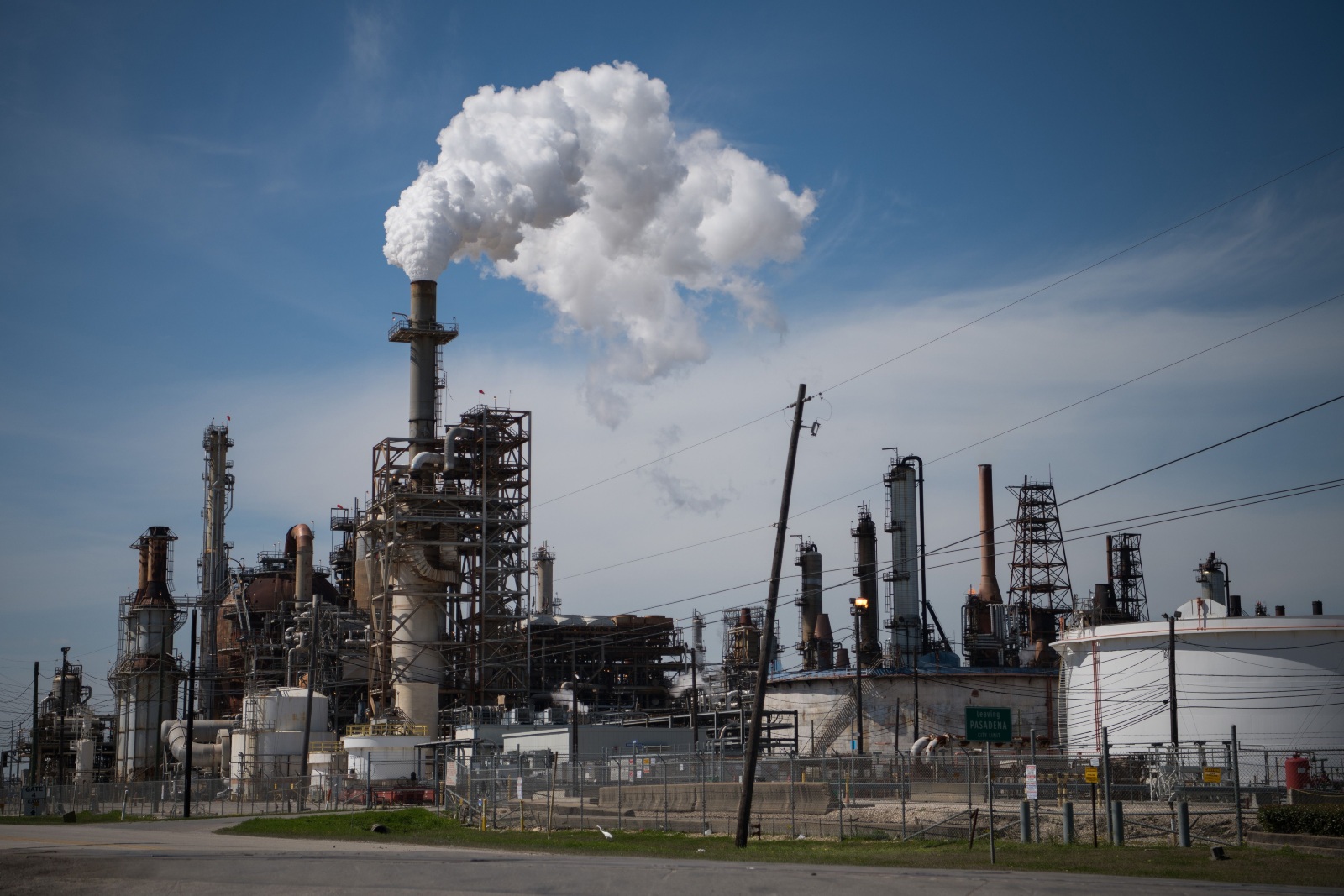
A half-hour later, the company released its first public statement. It came from Houston Refining’s owner, LyondellBasell, a Dutch corporation that’s one of the world’s largest plastics, refining, and chemical firms.
“While unpleasant, the smell does not pose any harm to our workers or community, and there is no need for nearby community members to be concerned or take any action,” the statement said. “We regret any concern this odor may have caused.”
When Hannah Molina saw the statement on Facebook, she didn’t feel relieved or reassured. She was livid.
She and her girls were still trapped in their house, and after a day and a half the stench was as strong as ever. Her head still felt light and her throat still stung. How could the nauseating odor possibly be harmless?
Babin wasn’t satisfied, either. She wanted as much hard evidence as she could get about the chemicals that had been released from the refinery.
Her investigators had used some of the department’s new equipment — basketball-sized, stainless-steel tools called Summa canisters — to trap air samples. Now the samples were being tested in the department’s refurbished lab, and the results would be run through its new chemical-matching machines.
That afternoon, LyondellBasell released another statement. This one came from Kara Slaughter, the company’s communication adviser for global external affairs. It included a timeline of the accident that was at odds with Molina’s experience and Pollution Control’s records.
According to Slaughter, the leak didn’t occur until approximately 5 p.m. on July 14, more than 30 minutes after someone on Facebook was already asking, “Does anyone know what that strange smell is outside?”
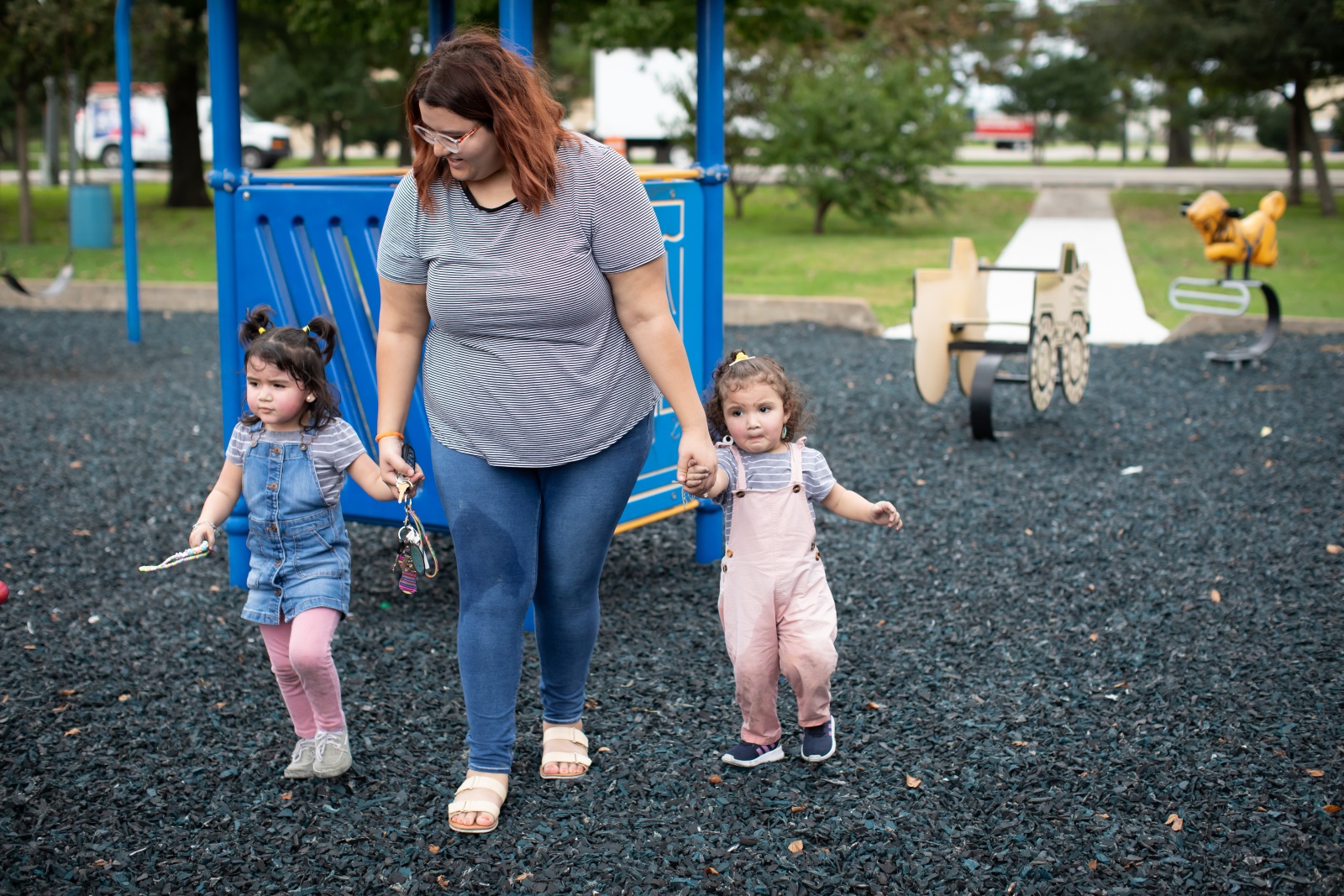
Slaughter said the odor didn’t surface until July 15 — long after Molina’s daughter had vomited and Juan Flores made his smoggy midnight drive.
Again, LyondellBasell’s message seemed reassuring.
“We understand that the material is odorous and community members may be able to detect a slight odor,” Slaughter’s statement said. “Air monitoring demonstrated no levels of concern for the community… As always, the health and safety of our people and the community are our highest priority.”
Slaughter declined to be interviewed for this story, and LyondellBasell didn’t respond to written follow-up questions.
LyondellBasell’s statement didn’t identify the chemicals its refinery had released. It was Pollution Control that made that information public just before 5:15 p.m. on July 16.
“PCS has identified chemicals of interest — carbon disulfide, dimethyl disulfide, methyl ethyl disulfide. Residents may experience irritation of the respiratory system and digestive system,” the agency said in a tweet. “Cause of odor has been capped and smell should dissipate later this evening… Sensitive populations should limit outdoor time and use face coverings.”
Short-term exposure to the kinds of chemicals Pollution Control found can cause nausea, shortness of breath, delirious behavior, and severe inflammation in the eyes, nose, and throat, according to the EPA and the U.S. National Library of Medicine. Long-term exposure can decrease sperm counts, disrupt menstrual cycles, and lead to heart disease.
LyondellBasell is a major player in the Texas petrochemical and refining industry. It operates in 32 countries, but its global headquarters are in LyondellBasell Tower, a 46-story skyscraper in downtown Houston.
The company’s facilities occupy more than 6,000 acres in Harris County and employ more than 6,000 workers. At least 20 plants and refineries in Harris County have federal air permits registered to LyondellBasell, according to a Public Health Watch analysis of TCEQ records.
Over the last two decades, the combined emissions from these plants have made LyondellBasell Harris County’s largest industrial source of two especially dangerous toxic chemicals — benzene and 1,3-butadiene — according to a Public Health Watch analysis of EPA data.
Most of those emissions are legal because they’re within the bounds of the company’s TCEQ-issued air permits. For instance, Texas allows Houston Refining to legally release 72,140 pounds of benzene per year and 136 pounds per hour, although it usually releases far less. The World Health Organization says there’s no recommended safe level of benzene, which is known to cause cancer in humans.
Releases that exceed a company’s hourly and yearly permit limits are considered illegal and can draw fines from the TCEQ. But in most cases the agency encourages companies to make voluntary fixes.
When the TCEQ does issue fines, they can be shockingly low.
LyondellBasell facilities reported 1,378 illegal releases of toxic chemicals between 2002 and 2021, but the $34.9 billion company paid only about $5.2 million in TCEQ fines. That’s just a third of the $15.5 million in salary and stocks it paid its then-CEO, Bhavesh “Bob” Patel, in 2020 alone.
Almost 200 of those illegal releases came from the 104-year-old Houston Refining plant, which processes as much as 268,000 barrels of crude oil per day. It’s among Harris County’s top 10 emitters of volatile organic compounds, particulate matter, and lung-damaging sulfur dioxide, according to the Public Health Watch analysis of TCEQ records.
Menefee, the county attorney, was well aware of LyondellBasell’s pollution history. The company’s 550-acre compound in La Porte, in the southeastern corner of the county, was of particular concern.
It has two shipping docks and three chemical manufacturing plants, and has been cited for more than 300 illegal releases since 2002, according to the Public Health Watch analysis. Its acetyls facility, which manufactures highly volatile acetic acid used in house paints and adhesives, has an especially egregious record. It has committed “high priority” violations of the federal Clean Air Act during every business quarter over the past three years, according to an EPA report that summarizes infractions by facilities across the country. Although the EPA oversees the Clean Air Act, state agencies are responsible for the law’s day-to-day enforcement.
The EPA defines a high priority violation as “likely to result in impacts that pose a significant risk to human health and/or the environment from the direct or indirect release of air pollutants.”
Just after sunset on July 27 — 13 days after LyondellBasell’s garlic-odor incident — a text message flashed across Assistant Fire Chief Bob Royall’s phone screen. Three words jumped out at him.
“Mass casualty incident.”
There had been a chemical spill in the acetyls unit at LyondellBasell’s La Porte complex. Workers were being rushed to the hospital.
Royall, who heads the Harris County HazMat team, was visiting family in Fort Worth, a four-hour drive away, when the alerts started coming in.
He jumped into his car and logged onto a Zoom call with his team.
The news was grim.
Two contractors were dead. Dozens more were being rushed to the hospital. As information began trickling in, a single question kept running through his mind: Just how big and bad is this?
If the acetyls escaped from the compound, people living in neighborhoods roughly a mile away would be at risk — and Royall’s team would have a full-blown catastrophe on its hands.
The flashing lights of emergency vehicles from all over the county quickly surrounded the industrial complex.
At this point, nobody — not even the plant managers — knew the extent of the damage. The worry now was that highly volatile chemicals from the facility’s acetyls unit might escape into nearby communities.
Royall decided he couldn’t hold back: He sent both of his HazMat units to the 550-acre industrial compound.
“We had three chiefs out there, the fire marshal, two deputy chiefs, a captain, seven personnel, and a supervisor,” he said. “I sent everything I had.”
Royall’s staff had prepared for situations precisely like this one.
Each HazMat agent had at least 160 hours of technical training, nearly double the state requirement. They’d sat through rigorous chemistry courses and learned how specific chemicals behave in specific situations. They had at least 150 hours of refresher training each year, while the state required just 10.
Like the Pollution Control department, the Fire Marshal’s Office is funded by the Harris County Commissioners Court. And like Pollution Control, its budget has increased significantly since Lina Hidalgo was elected county judge — from $6.3 million in 2018 to $10.25 million in 2021.
By the time the HazMat teams arrived, flashing lights already surrounded LyondellBasell’s fence line. Nearby roads were blocked off to make way for emergency vehicles. Firefighters from neighboring towns were there, along with EMS responders, Harris County constables and Latrice Babin’s Pollution Control agents.
The HazMat agents worked alongside LyondellBasell’s technicians, checking wind conditions and prowling the outskirts of the complex with handheld air monitors. They couldn’t move closer until they knew what dangers lay inside.
Harris County Attorney Christian Menefee tried not to check his phone after work hours. But the garlic-odor incident at Houston Refining had unsettled the county attorney and he’d begun breaking his own rule. He kept thinking another chemical release was just around the corner.
Menefee was in bed watching TV with his pregnant wife when his phone lit up at 9:42 p.m. on July 27. It was an email from Sarah Utley, the top lawyer in his department’s environmental division.
Menefee sat up and put on his glasses.
“This is a developing situation, but there has been a terrible incident at Lyondell,” Utley wrote.
Here we go again, Menefee thought. By his count, this was the fifth big petrochemical accident Harris County had suffered in the past month and at least the tenth since he’d taken office six months ago.
This one was by far the worst.
More than 30,000 liquid pounds of hazardous chemicals — including acetic acid, carbon monoxide, hydrogen iodide, methyl acetate, and methyl iodide — had spewed out of a chemical reactor and onto the facility’s floor.
Utley gave Menefee a play-by-play of what was happening on the ground. Two contractors were dead. Another was in critical condition. Five more had been rushed to a Houston hospital with burns and respiratory trauma. Twenty-seven were waiting to be taken to the hospital.
LyondellBasell workers were trying to contain the spill.
Some of the colorless liquid had escaped from the unit and onto the complex’s grounds, spilling into loose gravel, soil, surrounding ditches, and a pond. They built makeshift dams out of dirt and used vacuum trucks to suck up the overflow.
Workers sprayed water to suppress the deadly vapors that were rising from the chemicals. Others scrambled to test the pH levels of a nearby watershed for signs of contamination. If the chemicals reached the watershed, they could travel into a nearby bayou that fed into Galveston Bay, one of the country’s most important fisheries.
They contained the leak around 9:30 p.m. At 9:46 p.m., Pollution Control tweeted that there was “no known offsite impact.” The immediate danger had passed.
Now it was time for Royall’s HazMat teams to go into the acid-filled facility and remove the bodies of the two workers who had died. Dustin Don Day was 36 years old, an Army veteran whose wife had recently been diagnosed with breast cancer. Shawn Andrew Kuhleman was 32, married with two sons.
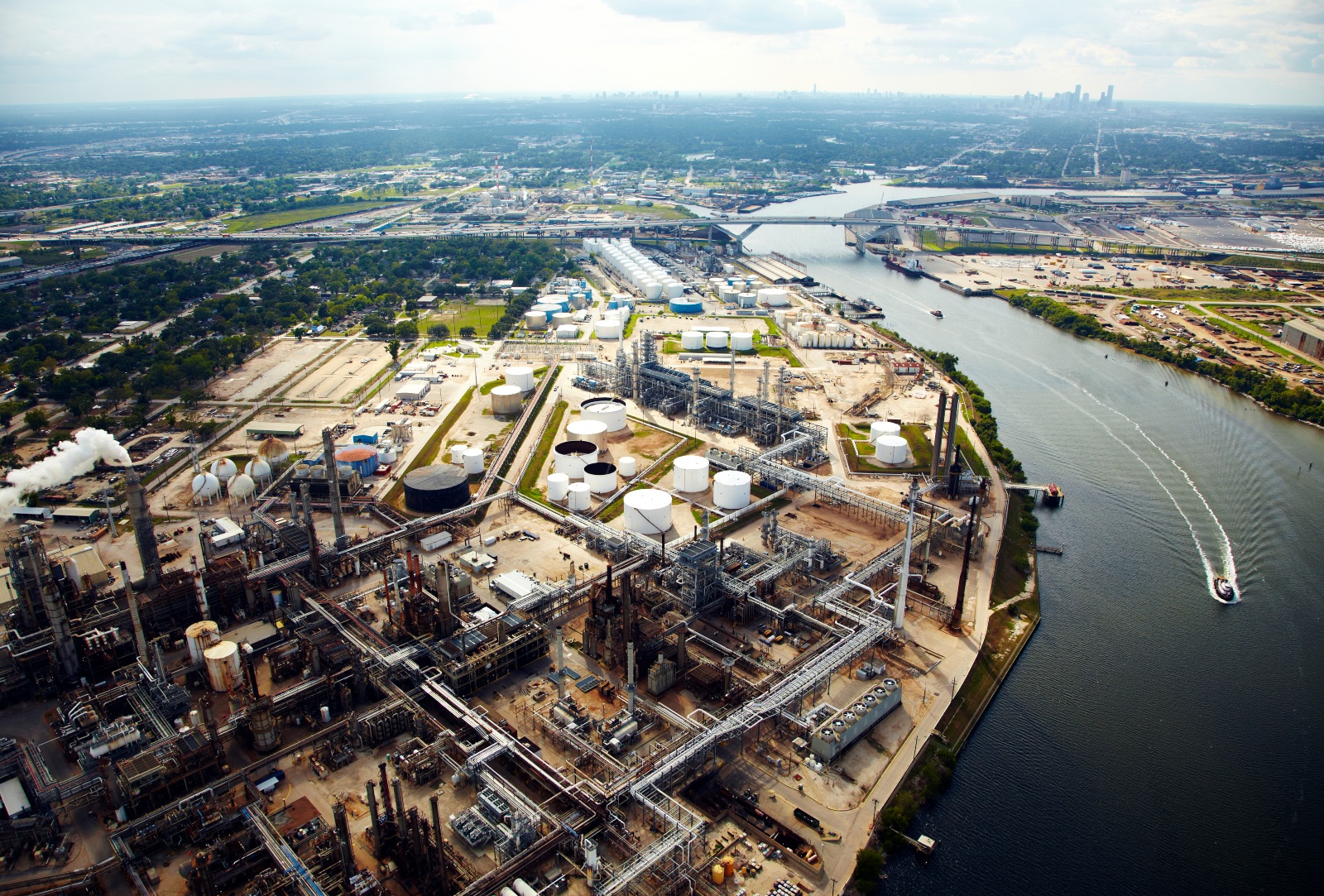
Removing the bodies was a perilous job.
The vapors that hung in the air were far less predictable — and even more dangerous — than the liquid concoction that had gushed outside the building. Acetic acid can severely burn even the tiniest patch of exposed skin. If large amounts were still in the room, the HazMat technicians’ circulatory systems could collapse and their kidneys could instantly fail.
The technicians used a chemistry database to determine what they needed to wear to protect themselves. It called for the heaviest-duty gear they had — billowy Tyvek suits lined with a Saran Wrap–like poly coating. An even thicker poly coating sealed the outside, with the gloves bonded directly to the suit. The only opening was a rubber-toothed zipper that was secured from the inside and covered by a protective flap.
Beneath the Tyvek suits, they wore flame-resistant coveralls, cooling vests to safeguard against heat exhaustion and additional garments in case their suits ruptured. Once they were fully dressed, they pulled on thick, chemical-resistant shields and face masks that were connected to oxygen tanks on their backs.
The equipment cost upward of $10,000 per person. A zipper alone was $500.
Royall had never lost a HazMat worker on the job. He didn’t plan to start that night.
“I told them, ‘You’re going into a very dangerous situation. But you’ve got the training. You’ve got the equipment. You’ve got the highest level of protection for the operation we’re about to do,’” he said.
At about 2 a.m. on July 28, four technicians entered the facility and found Day’s and Kuhleman’s bodies. The men’s work clothes had a strong, vinegar-like odor. Their bodies were covered with chemical burns and green, black, and brown spots where acid had splashed against their skin.
The technicians carried the bodies outside. Before they could be removed from the compound, they had to be decontaminated so nobody else would be exposed to the chemicals that still clung to them. The technicians carefully removed the men’s clothing and rinsed the bodies with water. Then they gently began cleaning them from head to toe using sponges and Dawn dish soap.
The cleaning was supposed to continue until the bodies reached a pH level of 7 — the level that’s normally considered safe for human contact.
But after several washes, the technicians couldn’t get the pH above 6. They decided that was “the most reasonable achievable pH close to neutral” the bodies could reach, given how many chemicals they’d been exposed to, according to the incident report from the Fire Marshal’s Office.
Finally, the corpses were zipped into body bags and handed over to the Medical Examiner’s Office. Royall’s last HazMat technician left the scene just before 4 a.m.
At 5:17 a.m. the all-clear alarm rang across LyondellBasell’s La Porte complex. The immediate crisis was over.
Christian Menefee’s alarm went off at 5 a.m. He hadn’t slept well. He knew he had a long day ahead of him.
The industrial tragedy was the leading story on just about every Houston news outlet. People wanted answers. And Menefee wanted to send a message to the thousands of industrial facilities that dominated the county where he had grown up.
Menefee huddled with Sarah Utley, who had been up most of the night monitoring the situation on an emergency Zoom call. Utley was more than his top environmental lawyer — she was someone he trusted. She’d been with the county attorney’s office since 2011 and she saw the opportunity he saw: A chance to show the people of Harris County that they could stand up to Big Oil.

Together, they laid plans to file a lawsuit against LyondellBasell, one of Harris County’s worst polluters.
They knew it would be a struggle because of two laws the Republican-dominated legislature had passed under Abbott’s watch.
A 2017 law gave the Texas Attorney General’s Office and the TCEQ the right of first refusal for any pollution-related lawsuit. The state had 90 days to step in and block Menefee from taking action.
The other law made sure the county wouldn’t benefit much if it did sue. It capped the county’s payout at slightly more than $2 million — a fraction of the $5.6 billion in profits LyondellBasell’s made in 2021. Menefee could sue for more, but Harris County wouldn’t see another dime. Any extra money would go to the state.
Despite these barriers, Menefee told his team to press on. He’d entered politics to push back against industry giants. And he felt a kinship with the dead workers and the families they’d left behind.
“It’s something I wake up every morning thinking about,” he said. “It’s on my mind all the time.”
Texas State Rep. Erin Zwiener was in Washington, D.C., when news of the deadly accident popped up on her Twitter feed. She was shocked — but not surprised.
Zwiener’s Central Texas district is a three-hour drive west from Harris County, but she knew the county’s pollution issues well. Since her election in 2018, she’d been trying to give the TCEQ more power over polluters, even though the odds were against her. The legislature had slashed the TCEQ’s funding by 20 percent since 2016, even as it increased the state budget by 16 percent.
In 2019, Zwiener, a Democrat, sponsored a bill that would have made polluters pay fines proportional to the profits they made when they sidestepped regulations. She co-sponsored another bill that would have required the TCEQ to notify state lawmakers every time a plant in their district was cited for an illegal chemical release.
Neither bill made it out of committee. So, in the spring of 2021, Zwiener tried again.
This time, she wanted to create an emergency alert system that would notify people of chemical accidents near their neighborhoods. She also wanted to eliminate the state’s “affirmative defense” loophole, which allows most polluters to avoid paying fines. Instead, they can file written reports describing how they had tried to prevent an accident and what they’d do differently next time.
According to a report by Environment Texas and the Environmental Integrity Project, polluters in Texas were fined for less than 3 percent of the nearly 25,000 illegal releases that occurred in the state between 2011 and 2016.
A TCEQ spokesperson disputed those findings. “The current enforcement rate for reported emission events is over 10 percent,” the spokesperson told Public Health Watch.
Zwiener’s conservative peers made it clear her ideas were non-starters. To get a bill out of committee, she’d have to think smaller.
The bill’s final version tied fines to inflation, so the fees wouldn’t lose value while polluters contested them in court. It ordered the TCEQ to study what would happen if companies were fined a dollar for every pound of chemicals they illegally released. And it gave polluters two hours, rather than 24, to give the TCEQ a written report of an “emission event.” That change would have forced LyondellBasell’s Houston Refining plant to report its garlic-like release at least 22 hours earlier than it did.
This time Zwiener’s legislation got a public hearing before the Texas House’s Environmental Regulation Committee. Juan Flores, the Galena Park resident who had tried to track down the garlic-like odor, traveled to the state Capitol in Austin to speak on its behalf.
When it was his turn to go to the lectern, Flores locked eyes with West Texas Rep. Brooks Landgraf, the Republican committee chair.
“He seemed like a good guy,” Flores said. “But as I was talking, it just went through my mind — like, is this dude even listening to me? … Just looking at him, I could tell he was just like, ‘Whatever, say what you have to say so we can move on.’”
Landgraf is a lawyer who represents oil and gas companies and manages his family’s mineral interests in the Permian Basin of West Texas. His office declined interview requests for this story. But his biography on the state government’s website says he is “working to repeal burdensome regulations that harm the Permian Basin’s oil and gas industry.”
Landgraf is running unopposed for reelection in November. He has been endorsed by the Texas Oil & Gas Association Good Government Committee, the Texas Alliance Oil & Gas Political Action Committee and the Oil & Gas Workers Association.

After listening to an hour of testimony, Landgraf voted with three other GOP committee members to kill Zwiener’s bill. In a surprise move, Republican Geanie Morrison joined the committee’s four Democrats and voted to send it to the House floor for debate.
But Zwiener’s victory was only symbolic, because House Speaker Dade Phelan placed the bill last on the legislative calendar, ensuring it wouldn’t come up for a vote before the full House.
Phelan, a Republican from Beaumont, has received more than $500,000 in campaign contributions from the oil, gas, and petrochemical industries since 2014, according to FollowTheMoney.org. His great-grandfather was a wealthy oilman tied to Texas’ famous Spindletop field.
Phelan didn’t respond to requests for an interview.
Three months after that painful defeat, Zwiener paced the streets of Washington, D.C., and felt powerless all over again.
She had fought for environmental reform, and she had lost. And now, as she watched news of the LyondellBasell accident pop up on her cellphone, she was 1,400 miles away, fighting another battle that would almost surely end in failure.
For two weeks, she and 55 other Texas Democrats had been holed up in the nation’s capital, trying to prevent the state legislature from passing a law that would make voting more difficult, especially for communities of color. By leaving Austin, the Democratic lawmakers had ensured — at least temporarily — that Republicans wouldn’t have a quorum, the minimum number of legislators needed to move the bill forward.
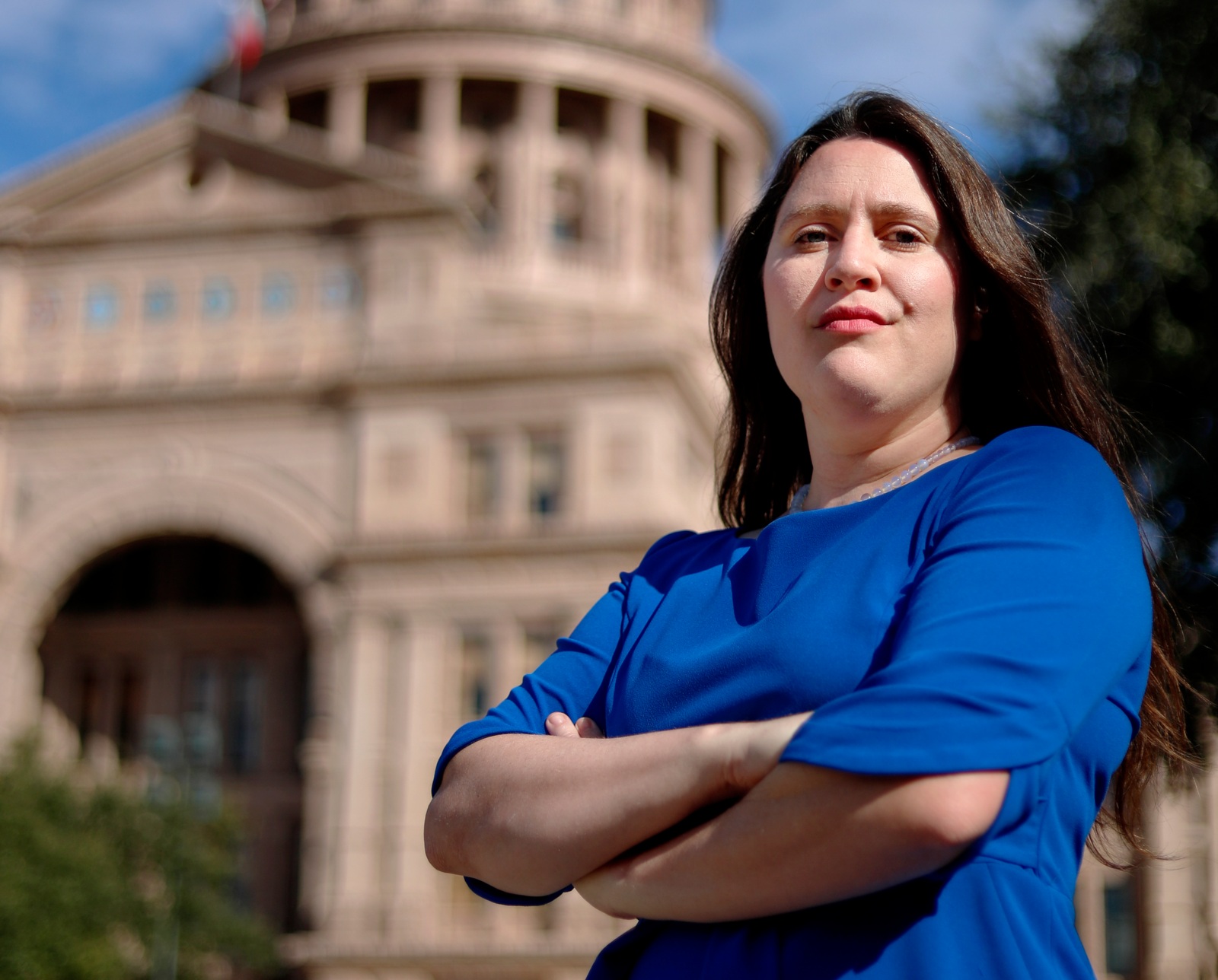
Senate Bill 1 didn’t call out Harris County by name, but its authors’ intentions were clear: The county’s record-breaking voter turnout in 2020 — and, more important, the pioneering voting reforms that had fueled it — was a threat to the state’s Republican establishment.
“I have news for Harris County: You’re not the capital of Texas,” Republican Lt. Gov. Dan Patrick declared at a news conference. “The state capital resides in Travis County. In the city of Austin. In this building. Not in the county judge’s or the mayor’s office.”
The governor also made it clear that Harris County was a prime SB 1 target.
“What Harris County did was a complete violation of the constitution by creating their own time, place, and manner for elections,” Abbott told Houston Public Media. “We, being the Republicans, we’re in no mood for additional compromise.”
Republican Attorney General Ken Paxton had singled out Harris County, too. During a June 2021 appearance on Steve Bannon’s “War Room” podcast, Paxton bragged about blocking Harris County’s 2020 plan to send mail-in ballot applications to all of its 2.4 million registered voters.
“Had we not done that… We would’ve been one of those battleground states that were counting votes in Harris County for three days,” Paxton told Bannon. “Trump would’ve lost the election [in Texas].”
Zwiener and the other Democrats trickled home from Washington in August 2021. The lawmakers couldn’t hide forever, especially after Speaker Phelan threatened to drag them back to Austin in handcuffs.
SB 1 sailed through the House and Senate less than two weeks later, and Abbott signed it into law on September 7.
Drive-through voting, which was mostly used by Latino, Black and Asian voters in 2020, is no longer allowed. Polling hours are sharply reduced and 24-hour voting is banned. Monthly “citizenship checks” search for undocumented immigrants on the voter rolls. Voting by mail is so restricted that public officials can be jailed simply for encouraging it.
On its surface, the law doesn’t have anything to do with Harris County’s efforts to rein in the petrochemical industry’s pollution. But by making voting more difficult for the communities most affected by the industry’s health hazards, SB 1 makes it harder for the politicians who champion their cause to win elections.
Hidalgo, the county judge who put environmental justice at the forefront in Harris County, is up for reelection in November. So is Adrian Garcia, one of the two Democrats on the commissioners court.
If either of them loses, Republicans will regain control of the court, and four years of hard-fought environmental gains will almost surely be wiped out.
State leaders are shaping Harris County’s upcoming elections in another way.
In October 2021, Abbott signed a statewide redistricting plan that redrew the political maps for the U.S. Congress and Texas Legislature to heavily favor white, conservative voters and dilute key minority voting blocs. The move, designed to keep Texas Republicans in power for the next decade, shuffled more than a million Harris County residents into new districts. The U.S. Department of Justice has sued Texas over the redistricting maps, saying they “deny or abridge the rights of Latino and Black voters.”
The state’s most prominent Republicans — Abbott, Patrick, and Paxton— are up for reelection in November. Each has received millions of dollars in campaign funds from oil, gas, and petrochemical donors. Each is favored to win, even though Paxton is under indictment for felony security fraud and is being investigated by the FBI for corruption and bribery.
Menefee, the Harris County attorney, sees the state’s new voting rules as existential threats to communities of color and to officials, like him, who are trying to protect them.
His office is working with the Brennan Center for Justice to sue the state over SB 1, arguing that it hinders election officials’ “ability to inform seniors and voters with disabilities about their right to vote by mail.” They won in federal court, but the decision was paused by the 5th U.S. Circuit Court of Appeals. Now he’s waiting for the Republican-dominated Texas Supreme Court to weigh in.
“It’s a threat to democracy… But it’s also a threat to the work that we’re doing,” he said. “If you can change the rules of the game so that 10 percent of Democrats in Harris County can no longer vote, or if you can take out 5,000 Black votes… you can get somebody in office who doesn’t believe environmental justice is a real thing. That’s how you flip seats.”
While the legislature was preoccupied with voting rights, Pollution Control and the TCEQ were investigating LyondellBasell’s deadly accident in La Porte.
The TCEQ found that the Dutch company had committed at least eight air-pollution infractions. Given the severity of the offenses, LyondellBasell can’t use the affirmative-defense loophole to reduce or avoid penalties for those offenses, the TCEQ said in “a notice of enforcement for compliance” to the company in October 2021. But it said the penalty “may be limited” if the company acted quickly to address the problem. The letter noted that the agency dedicates “considerable resources toward making voluntary compliance achievable.”
The TCEQ gave LyondellBasell 60 days to submit a plan to fix the problem and prevent future emissions. It did not specify how much the company could be asked to pay in fines.
A few weeks later, Pollution Control sent its own letter to LyondellBasell, a “violation notice” that said the company had committed at least seven air pollution infractions. Each violation carried a civil penalty of as much as $25,000 per day, the letter said. Some violations could include criminal penalties of as much as $250,000 and up to 10 years in jail.
Pollution Control gave LyondellBasell 10 days to submit a plan to fix the problem and prevent future emissions.
Pollution Control’s investigation found that LyondellBasell’s acetyls unit had recorded 13 unauthorized air pollution events in the year leading up to the deadly accident. They were considered minor events — so small that the company wasn’t even required to report them to the TCEQ, let alone be fined.
The agency found that the deadly accident began when workers from a third-party contractor, Turn2 Specialty Companies, mistakenly removed a pipe-valve cover during a maintenance operation. Kuhleman and Day had died, the investigators said, because LyondellBasell had “failed to provide the contractors with training, or any Standard Operating Procedures for the maintenance activity.”
But LyondellBasell blamed the accident on Turn2. In an email to Pollution Control, Lyondell said the contractor “was responsible for ensuring its personnel understood and could safely and successfully execute the maintenance activity.”
The workers were dead and injured, LyondellBasell added, because they had “exceeded the scope of the work permit.”
A lawyer for Turn2 told Public Health Watch it is cooperating with all the investigations, but “it would be premature” for the company to comment further. He said this was the first time any of its workers had died on a job.
By November 2021, Menefee’s office was ready to prosecute LyondellBasell for 96 pollution violations, including the seven mentioned in Harris County’s violation notice. Each infraction carried a penalty of as much as $25,000, which could add up to $2.4 million in fines.
But on Nov. 22, three days before the state-sanctioned 90-day waiting period expired, Attorney General Paxton’s office informed Menefee that the state was taking the case — that Harris County could not “institute suit for civil penalties against LyondellBasell Acetyls.”
It’s unclear how many violations the state will pursue against LyondellBasell or what kind of fines it could face. Documents Paxton’s office filed in court say the state will seek “monetary relief over $250,000 but not more than $1,000,000… or alternatively monetary relief over $1,000,000.” Asked to explain why the state is still vacillating over how much to ask for, a spokesperson for Paxton declined to answer, saying, “This litigation is pending and the investigation is still ongoing.”
Two federal agencies are also investigating the accident at La Porte.
The U.S. Occupational Health and Safety Administration, or OSHA, found that LyondellBasell had committed four “serious” violations, including failing to inform contractors “of the known potential fire, explosion, or toxic release hazards” related to their work. It proposed a fine of $54,612. OSHA also cited Turn2 for four “serious” violations and proposed a $53,247 fine.
Both LyondellBasell and Turn2 are contesting the penalties.
A separate investigation by the U.S. Chemical Safety and Hazard Investigation Board won’t be completed until 2023. The board is backlogged with cases after being short-staffed and underfunded for years.
The families of the men who perished or were injured in LyondellBasell’s accident are seeking justice in a different way.
Day’s family turned to Houston-based lawyer Benny Agosto Jr., who has represented other industrial accident victims in Harris County.
Agosto knows how hard it is to win against corporations backed by arsenals of top-tier lawyers, so he only takes cases supported by strong medical evidence. In Day’s case, Agosto has the autopsy report from the Harris County Medical Examiner’s Office. It says Day’s face and body were covered with green, black, and brown chemical burns. His voice box had turned green, his tongue had turned brown, and his eyes showed green discolorations.
Agosto also represents 27-year-old Seth Wheeler, who survived the accident. Agosto said Wheeler suffered internal and external acid burns, and his lungs were so badly damaged that for days he needed a ventilator to breathe. He required multiple surgeries on his face and eyes and will need more surgery in the future.
Wheeler, like the Day family, is seeking at least $1 million in damages. LyondellBasell didn’t respond to questions about the lawsuits, but in court filings the company has denied the victims’ allegations of gross negligence and wrongful death.
Agosto is preparing to take the cases to trial. But legal battles against powerful companies can drag on for years and many clients agree to out-of-court settlements. That way, they get their money faster and the company avoids the negative publicity of a trial.
Agosto knows it’s not a perfect solution. But he says it’s the best way he can help “folks that have been downtrodden and pushed down.”
And the garlic-odor incident on July 14, 2021? The LyondellBasell accident that sickened people in Galena Park and Jacinto City but didn’t kill anyone?
Harris County and the TCEQ investigated that leak, too.
The TCEQ found that the stench settled in after more than 2,300 pounds of chemicals — several of them known to cause breathing problems and nausea — escaped from one of the large, white storage tanks in the Houston Refining compound. The tanks have floating roofs that are supposed to withstand severe weather and protect against explosions and fires. But heavy rainfall had caused severe corrosion and multiple holes on the roof of Tank 420. The chemicals escaped through the holes, flowed down the roof’s rainwater drain, and spilled onto the ground.
LyondellBasell argued in emails to the TCEQ that the spill couldn’t have been prevented — even “by good design, maintenance, or operation practices.” The company said no problems were detected when the tank was given its annual environmental inspection in October 2020. The tank’s last third-party mechanical integrity inspection was in 2013, LyondellBasell said.
In October 2021, the TCEQ sent Houston Refining a “notice of enforcement for compliance” that said the company had committed at least 10 air pollution violations over a span of 45 hours. Three were for failing to prevent an unauthorized emission due to “inadequate operation and maintenance practices.” Seven were for failing to accurately report the incident.
For each violation, the TCEQ encouraged Houston Refining to “submit a written description of corrective actions taken and the required plan/or documentation necessary to address the outstanding alleged violation to prevent recurrence of a same or similar violation.”
The TCEQ didn’t mention how much LyondellBasell could be fined or set a deadline for the company to file a plan to fix the problem.
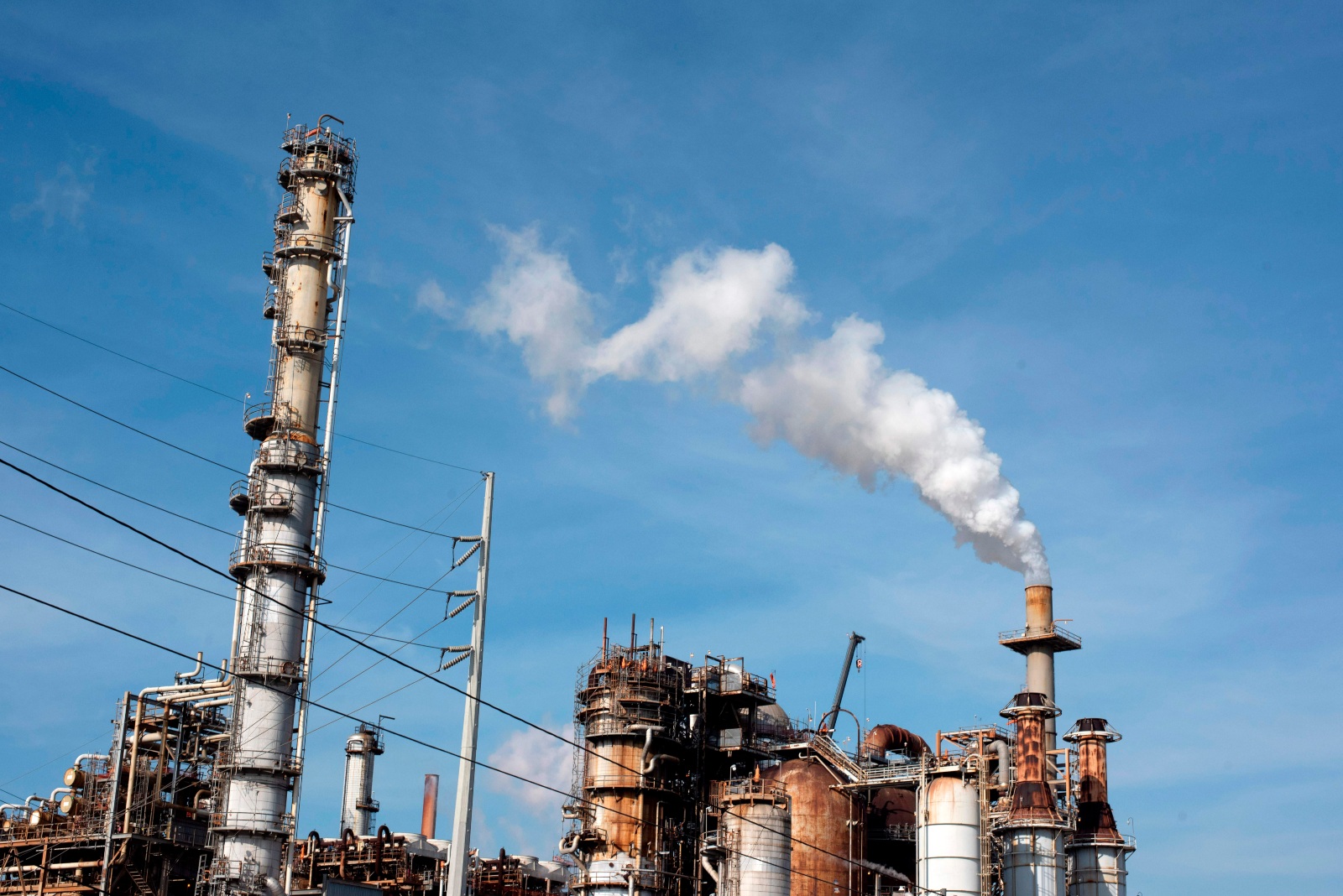
A few weeks later, Pollution Control sent Houston Refining a separate letter, a “violation notice.”
It said LyondellBasell had committed at least one air pollution infraction: Releasing contaminants into the air “in such concentration and of such duration” that it interfered “with the normal use and enjoyment of property located in the Galena Park area.” It said that violation carried a civil penalty of up to $25,000 per day, and included potential criminal penalties of up to $250,000 and up to 10 years in jail.
Pollution Control gave LyondellBasell 10 days to submit a plan to fix the problem and prevent future emissions.
At the same time, Menefee’s office was preparing to prosecute the corporation. It drew from Pollution Control’s investigation, which said the agency had received 72 complaints about the chemical release from people who “expressed fear of leaving their home” and experienced “headaches, nausea, diarrhea, vomiting, difficulty breathing,” among other problems. The investigators themselves “experienced irritation of the eyes and throat while conducting an odor survey in the Galena Park area.”
Menefee’s office planned to charge LyondellBasell with 114 pollution violations, including the one mentioned in the violation notice. Harris County could ask for up to $2.85 million in fines.
But once again Attorney General Paxton’s office stepped in and exerted its authority to take over the case. It notified Menefee’s office of its decision on March 10, 2022 — the day before the 90-day waiting period expired.
The court documents Paxton’s office has filed so far don’t specify the number of charges LyondellBasell is facing but say the state will seek “civil penalties that could exceed $100,000.” When asked if LyondellBasell could use the affirmative-defense loophole to reduce or eliminate those fines, the TCEQ declined to comment.
LyondellBasell has since announced that it will close Houston Refining by the end of 2023 as part of its larger plan to leave the refining business. But industry experts think the facility will probably continue operating under new ownership.
On March 1, Texas held its 2022 primaries — the first elections with the new voting rules in place. The results in Harris County were so stunning that they made national news.
Nearly 7,000 ballots — about a fifth of all the mail-in ballots cast in the county — were tossed out, mostly because of technical mistakes people made while trying to navigate the state’s rigid new voting requirements.
“We’ve been saying for a while, that the new voter suppression laws in Texas are designed to do just that. And now we’ve got the receipts,” County Judge Lina Hidalgo told CNN as the first ballots were being flagged for rejection. “It’s throwing sand into the gears of democracy.”
By comparison, only 135 ballots were rejected in the 2018 midterm election.
The stakes will be much higher on Nov. 8, when Hidalgo and Democratic County Commissioner Adrian Garcia will face their Republican opponents. Garcia won his 2018 race by just over 2,000 votes. Hidalgo won by fewer than 20,000 votes.
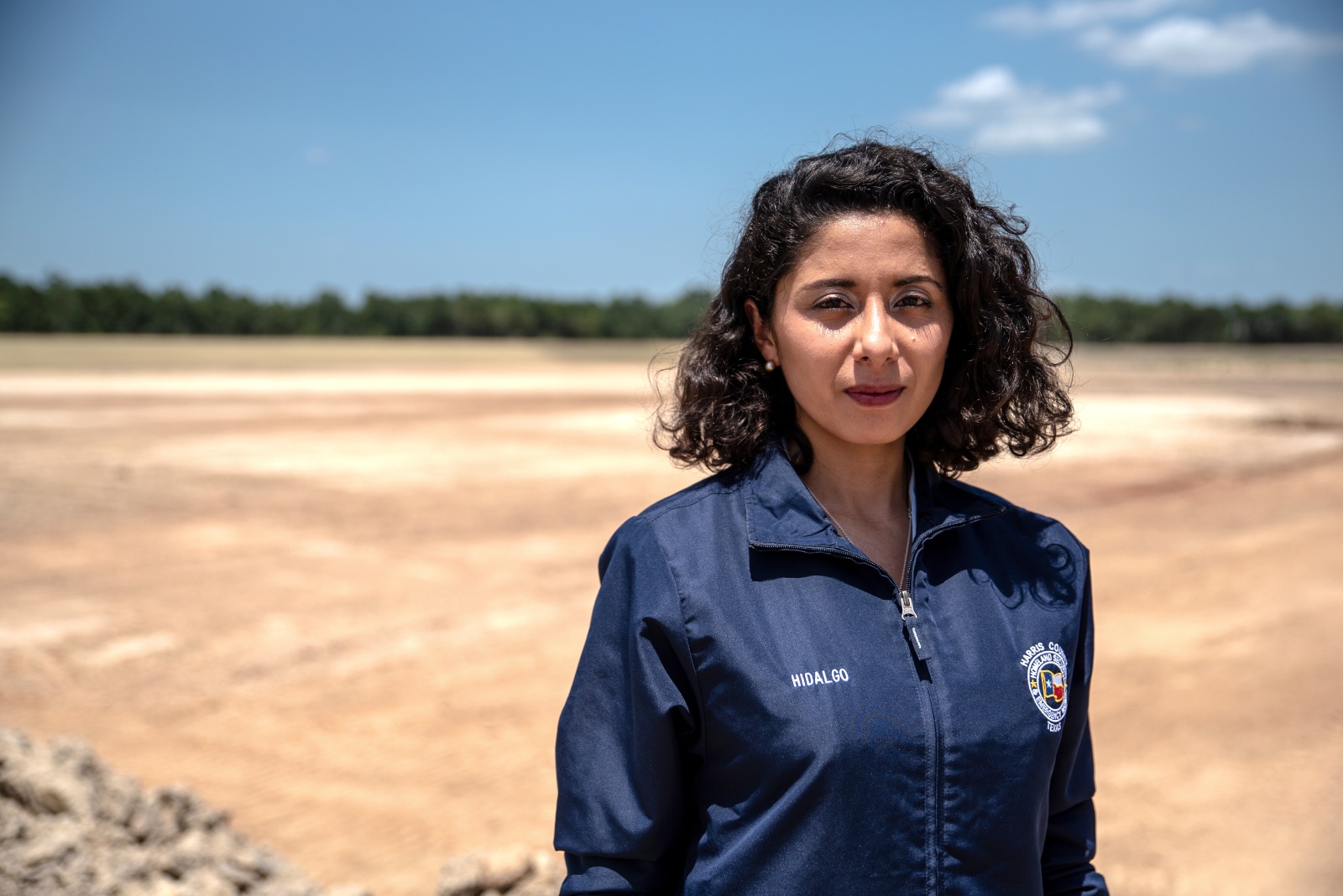
Hidalgo’s reelection campaign has been complicated by a scandal in her office. In April, three of her staffers were indicted on charges that they improperly awarded an $11 million COVID-19-related contract to a consulting firm that received a lower rating than other bidders in an initial review. At a recent news conference, the county judge said the investigation is a politically motivated effort “to destroy, to harm my campaign.”
If either Hidalgo or Garcia loses, Republicans will have enough votes on the commissioners court to roll back the county’s recent environmental justice gains.
In February, the two Republicans who currently sit on the court indicated that’s exactly what they would do.
Tom Ramsey proposed a budget for the next fiscal year that would have cut Pollution Control’s funding by nearly 20 percent. Jack Cagle proposed slashing public health funding by 47 percent and shutting down the local elections department that had carried out the 2020 voting reforms. Both would use most of the savings to boost funding for law enforcement.
None of these cuts was included in the budget that Hidalgo and the two Democrats on the court approved by a 3-2 vote. Instead, the new budget increases Pollution Control funding by $1.2 million for the upcoming fiscal year.
For Juan Flores, who has breathed East Harris County’s foul air since he was born, all this political wrangling is just background noise. He has never counted on politicians to rescue the neighborhood where he grew up. He believes it’s up to people like him, who are doing grassroots organizing, to change things.
As part of his work with Air Alliance Houston, he recently installed two new Apis air monitors in Galena Park — including one on Clinton Drive, where he had desperately searched for the garlic-like odor last July. The $11,000 machines are the size of a bread box and give real-time readings about ozone, nitrogen dioxide, particulate matter, and volatile organic compounds. Residents can view the readings using an online dashboard. That way they can better understand the dangers of pollution — knowledge Flores thinks came too late for him.
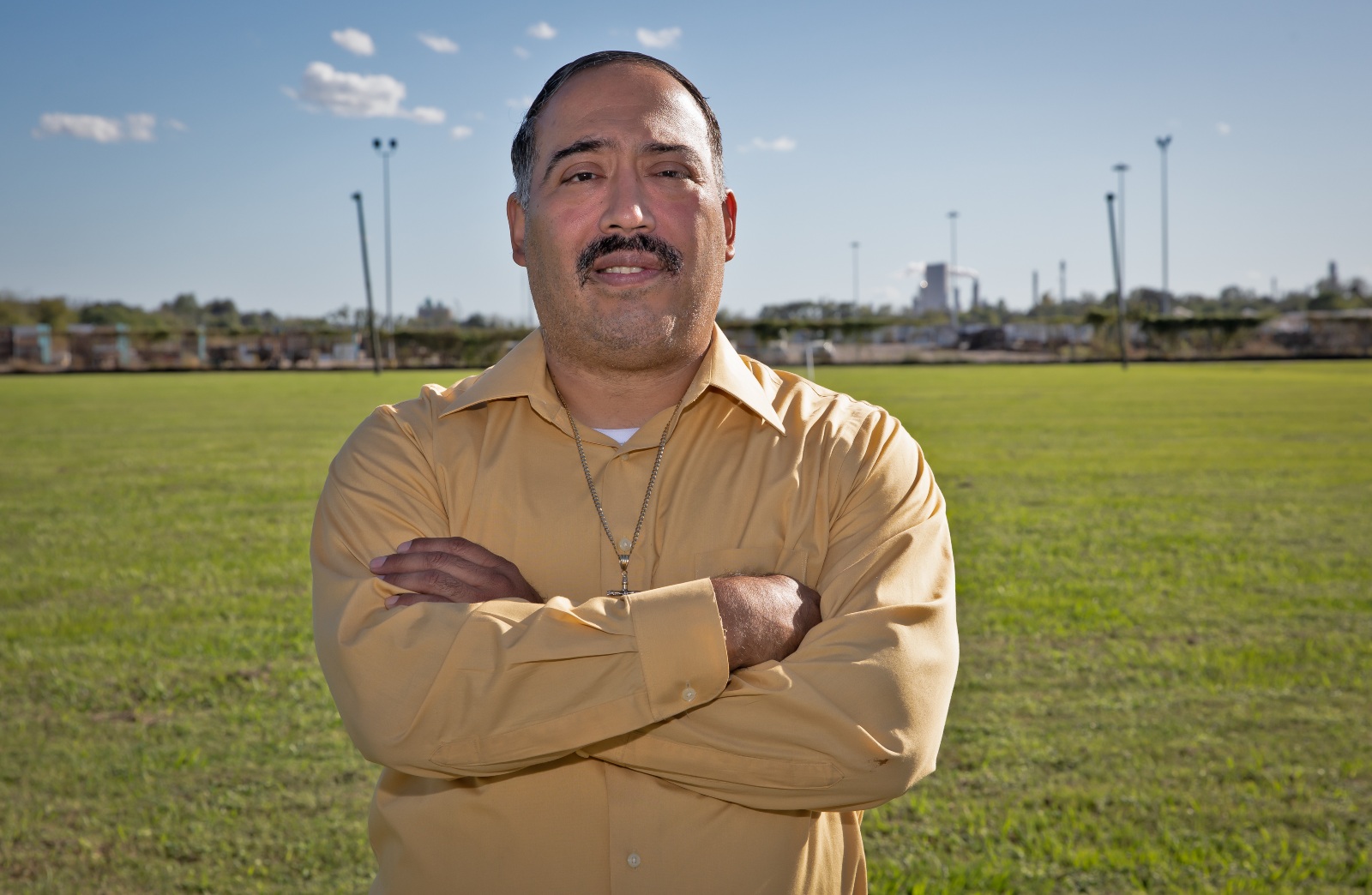
These days Flores worries a lot about dying young. His father died more than two decades ago, on a refinery floor, at the age of 51. His father’s warning — Don’t do what I do, mijo — saved Juan from a life of petrochemical work. But Flores, 44, fears that simply living in his small, polluted town will bring him an early death, too. To protect himself and his family, he has cancer insurance that covers chemotherapy and other treatments.
“Any time I see an abnormality in my body, I start freaking out and visit the doctor,” he said. “I just want to live a little longer, because my daughter’s so young.”
Dominique recently turned 6 and is free of the cancer she was born with. Flores’ son, Jean, just finished his freshman year at the University of Houston. The teenager is still haunted by his experience in 2019, when he needed steroids to ease his breathing after a fire at the Intercontinental Terminals Company plant released a staggering amount of benzene. He hopes to move away after college.
Flores understands why his son wants to leave. His own brothers and sisters all moved away years ago. But he can’t bring himself to abandon Galena Park.
He sees his fight against serial polluters as something bigger than himself. It’s his chance to protect the only home he’s ever known — and to give the next generation the clean air he never had.
In March, eight months after the garlic odor invaded Galena Park, Flores and his family headed to the Caribbean for a seven-day break from refinery flares and rumbling trains.
They’d never been on a cruise, and Flores was eager to soak up the experience. He wants to make as many memories as he can before it’s too late.
“I can see it coming 15 years from now. Juan, you’ve got cancer,” he said. “You can’t make peace with that. You just have to live your life one day at a time. And if it happens, it happens.”
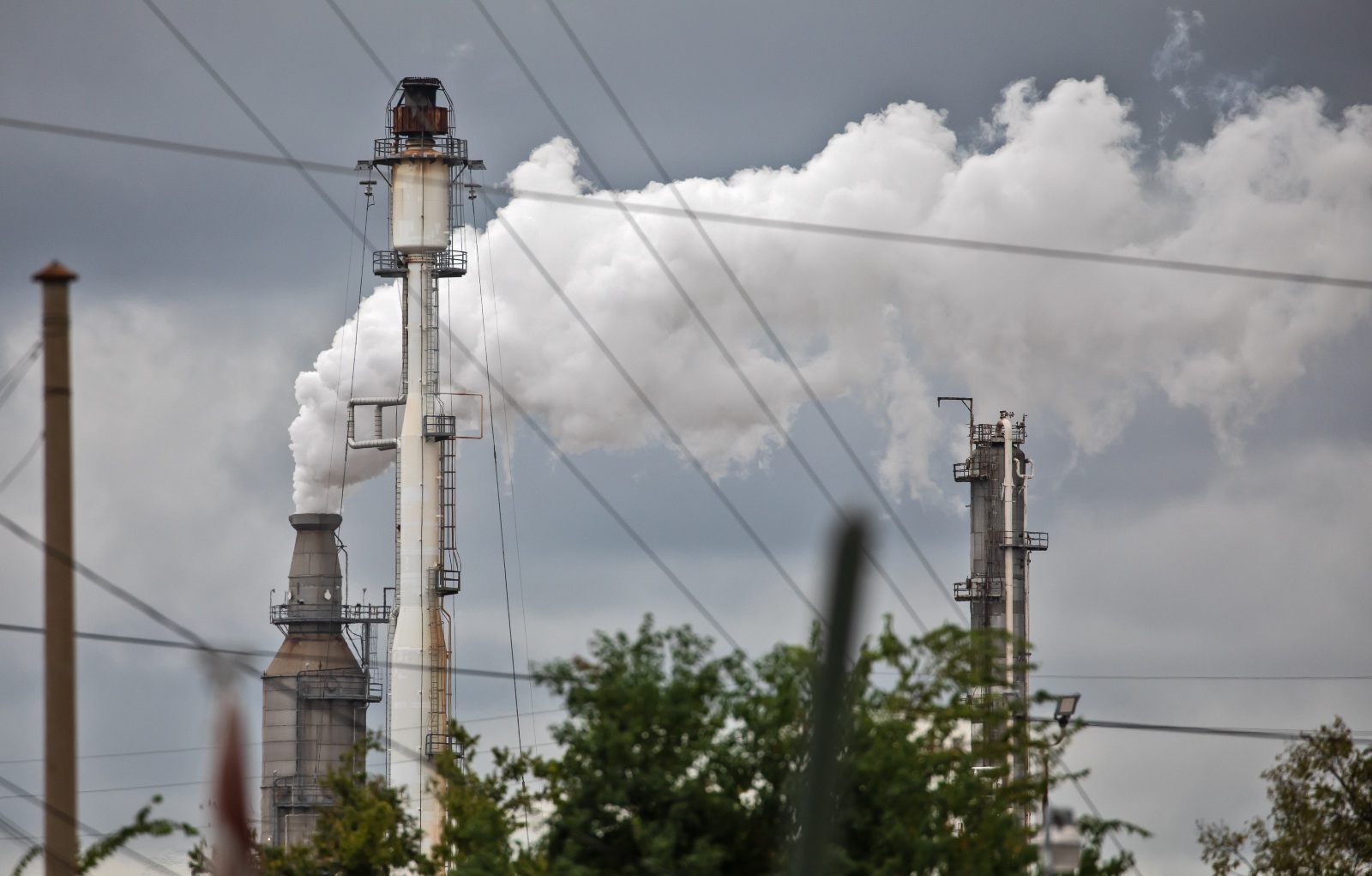
Hannah Molina, whose toddlers were sickened during the July 14 incident, is trying to get her family out of East Harris County before the next big leak happens.
To save enough money to move, her husband is taking on double shifts and overtime at the sign-making company where he works. She has started a podcast about motherhood, “The LifeChat Experience,” to try to bring in a little extra money while she cares for the girls.
The family had hoped to leave by the end of this year. But with inflation, it’s hard just to make ends meet, let alone save. Now they’re aiming for 2023.
“We can’t catch a break,” Molina said. “Maybe it’s just not our time right now.”
According to TCEQ records, more than 150 chemical leaks have occurred in Harris County in the nine months since the garlic-like odor settled over Galena Park and Jacinto City. Asked whether it does enough to protect communities from pollution, the TCEQ told Public Health Watch it “does all it can to support air quality within the boundaries of state law.”
This story was reported and written by David Leffler and Savanna Strott. Kelly Martin and Chris Campbell handled graphics. Photography was produced by Julie Dermansky and Blaine Young. Kelly Martin, David Fritze, and Lena Huang did the design. Illustration was done by K. Amelia Bates. Katherine Bagley did additional production.
This project was edited by Susan White, Jim Morris, and Lynne Perri. It was copy edited by Suzanne Choney and fact checked by Savanna Strott and David Leffler.
*Correction: An earlier version of this story incorrectly said that a bill introduced by state Rep. Erin Zwiener was never scheduled for a House vote. In fact, the bill was placed last on the legislative calendar, ensuring it would not come up for a vote.
